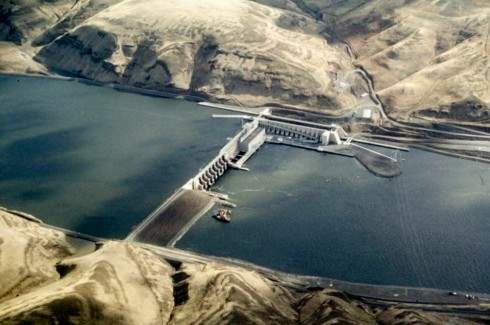forum
library
tutorial
contact

A Bold Plan for Salmon Restoration
Puts Idaho on Right Course
by Tom Stuart
Idaho Mountain Express, June 12, 2024
|
the film forum library tutorial contact |

|
A Bold Plan for Salmon Restoration
by Tom Stuart
|
 A bold plan for salmon restoration puts Idaho on right course
A bold plan for salmon restoration puts Idaho on right course
Salmon are central to the Idaho way of life, and even more essential to Idaho's Native Americans. Recently, a landmark agreement was reached that focuses on restoring abundant salmon in the heart of Idaho -- places like the Salmon River.
Leaders of "Six Sovereigns" (four Columbia Basin Tribes, states of Washington and Oregon) plus representatives of fishing, conservation and energy groups recently signed the Columbia Basin Restoration Initiative (CBRI), an agreement with the U.S. government that provides a foundation to restore Snake and Columbia River salmon. The agreement modernizes energy production, increases resiliency of the river system, accommodates farmers and provides stability for communities throughout Idaho and the Columbia Basin.
The agreement establishes federal commitments, including $1 billion in funding to implement key elements of the CBRI, with investments in habitat restoration and clean water. It is a path to salmon recovery and a major step toward a future where Idaho salmon and affordable energy coexist.
All this comes at a critical moment. The Northwest is undergoing a rapid transition to meet its energy needs and climate goals -- and to address the escalating pressures of a warming climate. Hotter summers and colder winters, when hydrogeneration drops, confirm that we must diversify our energy sources. Last winter's reduced snowpack will further stress the hydro-system, forcing us to deal with the risks of over-relying on dams for energy. As a result, the Bonneville Power Administration (BPA) has downgraded its financial outlook for 2024.
As we modernize infrastructure in the Snake/Columbia Basin and mitigate the impacts on salmon caused by lower Snake and Columbia River dams, BPA has a vital role to play. To meet its commitments in the signed agreements, BPA must modernize its energy services with renewed focus on energy efficiency, demand response, wind, solar, battery storage and transmission -- and reduce reliance on dams. There is good news on this front: It is affordable. A preliminary analysis by BPA shows that its $300 million commitment and operational changes under the Columbia River agreement will affect electric rates less than 1% over the next 10 years. John Hairston, BPA's administrator, said so in a recent congressional hearing.
Part of the solution will come through developing new tribal clean energy programs, which can replace the power that comes from the four lower Snake dams. Energy experts say it clearly: with smart planning and investments, the energy provided by the lower Snake River dams can be replaced.
The CBRI agreement also moves to honor treaty obligations to tribes, acknowledging that fishing rights are meaningless if there are no salmon to catch. We still have a lot of work to do to ensure treaty obligations are actually honored -- that the salmon promised to Shoshone-Bannock and Nez Perce people is a meaningful and harvestable share.
Modernizing, strengthening and diversifying the region's energy grid is well within our reach -- and it is essential if we want a future that includes salmon and energy, along with the ecosystems that make Idaho special.
Idahoans in all walks of life can celebrate this historic agreement. The unity and leadership that guided the agreement puts Idaho and the Northwest on the right course. Regrettably, this deal occurred without Idaho's leadership. But it will take the collective work of all NW states, tribes, stakeholders and congressional delegations to seize the momentum and deliver the promises the United States has made -- to build a better future for Idaho and the Northwest.
learn more on topics covered in the film
see the video
read the script
learn the songs
discussion forum
